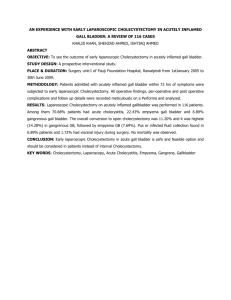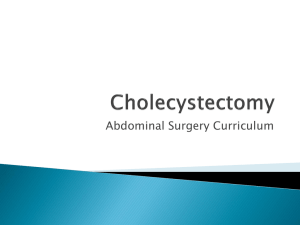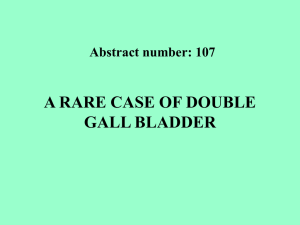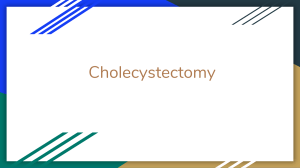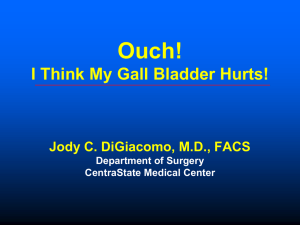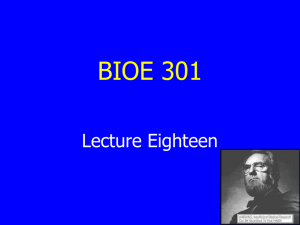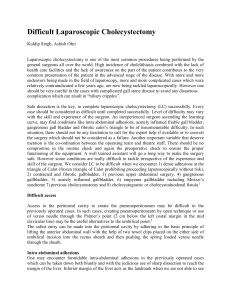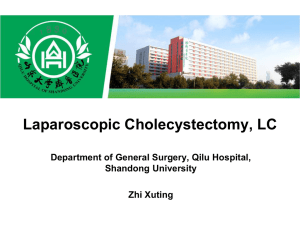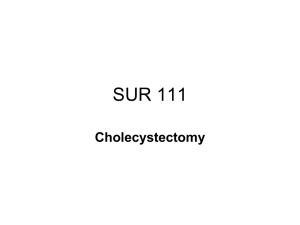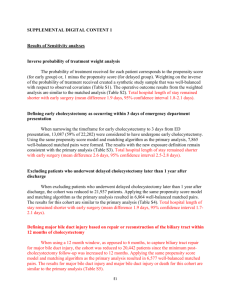Laparoscopic Cholesectomy - University of Kentucky | Medical Center
advertisement
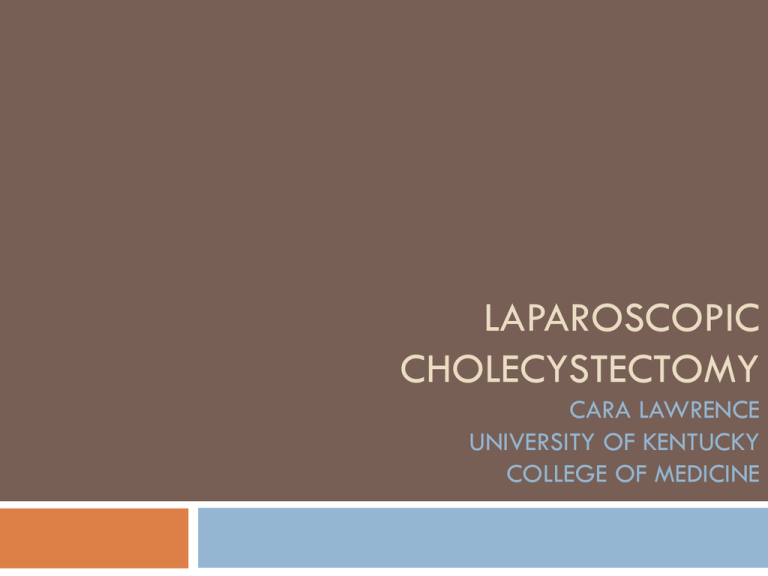
LAPAROSCOPIC CHOLECYSTECTOMY CARA LAWRENCE UNIVERSITY OF KENTUCKY COLLEGE OF MEDICINE Symptoms pain located URQ to upper middle of the abdomen. Pain occurs within minutes of a meal clay colored stools Jaundice (obstructive/conjugated) Nausea Vomiting Mild fever Work up Blood tests: Amylase and Lipase- digestive enzymes made by the pancreas Bilirubin- jaundice (typically measures both BC/BU) CBC Liver function Abdominal Ultrasound Useful for detecting gallstones and location Abdominal CT scan Abdominal X-ray Oral cholecystogram -Eat high fat meal at noon, low fat meal at night, take tablets and then NPO until the x-ray the next day Gallbladder radionuclide scan- 1-2 hr scan that takes pictures to detect inflammation or gallstones Abdominal Ultrasound Example From St. Luke’s Health System Resource Library Diagnosis 1 Acute/Chronic cholecystitis: Cholelithiasis -90% of cases & often obstruction of the cystic duct, in chronic it is not understood if gall stones are what first initiate symptoms Rarely tumors: cholangiocarcinoma freq: 0.6/100,000 malignancy of the biliary tree Biliary dyskinesia: (chronic acalculous gallbladder disease) Diagnosis 1 Cholelithiasis (gallstones)- 10-20% of the population Pigment stones and Cholesterol stones Women 2x more likely to have, aging also plays a role Choledocholithiasis- if gallstone(s) located in the common bile duct From Telepathology.com Laparoscopic Cholecystectomy Advantages Contraindications2 Low mortality Shorter hospital stay Quicker recovery Decreased cost Gall Bladder or Bile duct tumors Portal Hypertension Acute pancreatitis Biliary fistula Mirizzi’s Syndrome Pregnancy in the final trimester Cardiopulmonary or Coagulation disorders Instrumentation 2 or 3 5mm trocars 1 or 2 10mm trocars 10mm 30° scope liver retractor/ grasper(s) straight dissectors clip applier Scalpel and Suture Metzenbaum Scissors L-hook electrocautery 5 mm/10mm, irrigation & suction Cholangiogram depending on location of stones extraction bag Structures to avoid Duodenum and colon on trocar placement Common bile duct (2-7% chance of injury) Common Hepatic Duct (can be mistaken for cystic artery in anatomical variations) Liver and other instruments with L-Hook Also note any variations such as an accessory hepatic ducts Anatomy in the Operating Room Falciform Ligament Fundus of Gallbladder Infindibulum of Gall bladder Calot’s Triangle Cystic Duct (connecting from Common Bile Duct) Common Hepatic Duct Liver Cystic Artery (often arises from the right hepatic artery, but note that there are variations Calot’s (Lund’s) Node Operating Room Setup Placed in a reverse Trendelenburg and tilted slightly to the left after insertion of optic trocar Retrograde Laparoscopic Cholecystectomy Steps Prep the patient Placement of first trocar (midline navel) Creation of Pneumoperitinium Final Diagnosis (2 min 47 sec) Place patient in Reverse Trendelenburg position slightly rotated to the left Apply local anesthetics and 2-3 other trocars under visualization of scope (4 min 50 sec) Trocar placement Surgical Trocar (both are often 5mm) Optical Trocar Retraction of gall bladder/live r Retrograde Laparoscopic Cholecystectomy Steps Assistant grasps fundus of gallbladder and retract superiorly Grasp infundibulum of the gallbladder (may need some dissecting) Create tension by pulling slightly superior and laterally on the infundibulum of the gall bladder Dissect Calot’s Triangle starting towards the infundibulum of the gall bladder and working your way to the common bile duct (12 min 51 sec) Infundibulum of Gall Bladder Cystic Artery Cystic Duct Retrograde Laparoscopic Cholecystectomy Steps Using the gallbladder as point of reference, place 2 distal clips and 1 proximal clip along the cystic duct. (30 min 3 sec) Divide making sure both jaws are visible to prevent vascular injury Retrograde Laparoscopic Cholecystectomy Steps Using the gallbladder as point of reference, place 2 distal clips and 1 proximal clip along the cystic artery. (39 min 21 sec) Divide and cauterize/clip any necessary collateral arteries Retrograde Laparoscopic Cholecystectomy Steps (45 min 9 sec) Dissect away the posterior wall of the gall bladder using an L-Hook. Make sure Lhook does not come in contact with other instrumentation to prevent tissue damage Retrograde Laparoscopic Cholecystectomy Steps Remove gallbladder via bag or trocar Irrigate and Suction Final visualization check Deroofing of ovarian cyst (55 min 28 sec) Irrigate and suction Release of CO and steri-strip or suture 2 trocar incisions Post-operative care Transfer to PACU Discharge typically within 24 hours Post-operative pain can typically be relieved with OTC pain medications Patient can resume normal daily activities in roughly 24 hours Heavy lifting should be avoided for a few weeks Watch for drainage, bleeding, swelling around incision sites, and for mild fever, as this could indicate complication References 1. Kumar , V., Abbas, A., & Fausto, N. (7th Ed.). (2005). Robbins and Cotran: Pathologic basis of disease. Philidelphia, PA: Elsevier Saunders. 2. Kremer, K., Platzer, W., Schreiber, H., Steichen, F.M. (2001). Minimally Invasive Abdominal Surgery. New York, NY: Theime. 3. Berci, G., Nobuto, T., Phillips, E.H. (2008). A pocket atlas of laparoscopic surgery. Tuttlingen, Germany: Endo:Press. 4. Longstreth, G.F. (2009, July 6). Acute cholecystitis. Retrieved from http://www.nlm.nih.gov/medlineplus/ency/article/000264.htm 5. Swierzerski, III, S.J. (2001, November 1). Cholecystectomy: preoperative procedures, postoperative procedures, complications. Retrieved from http://www.surgerychannel.com/cholecystectomy/preop.shtml
